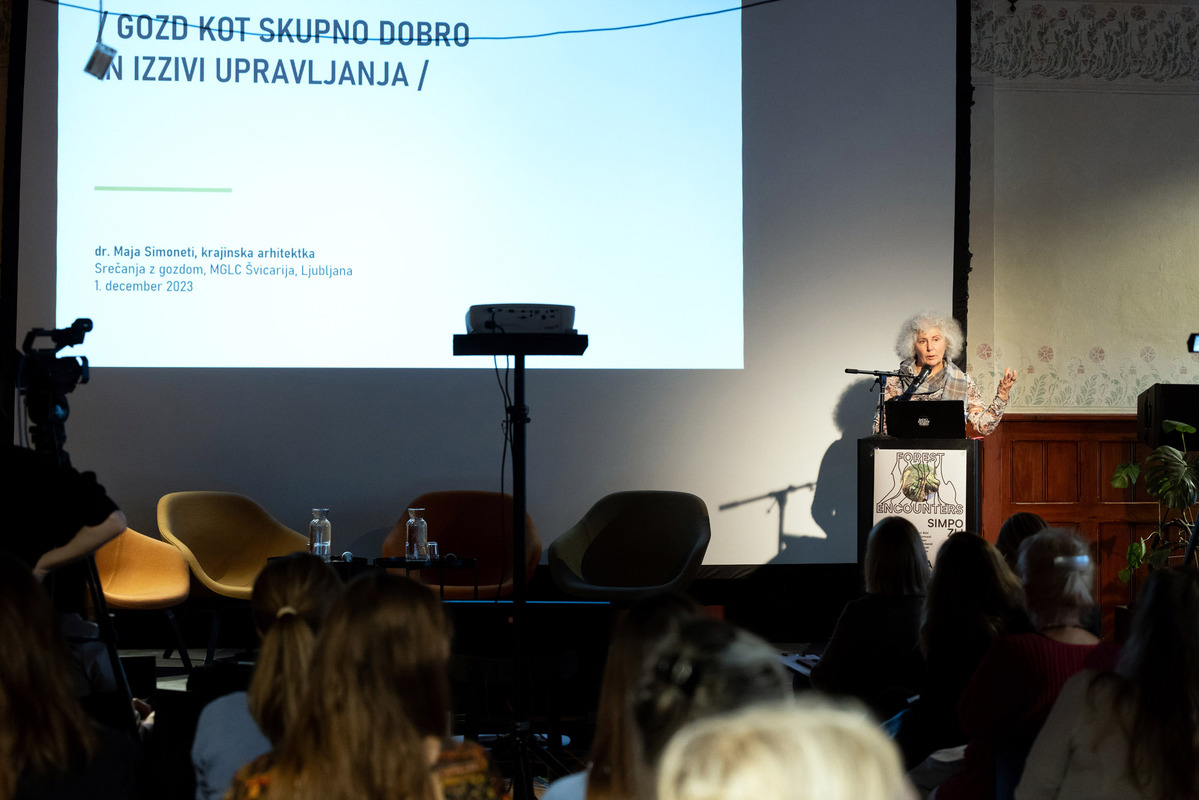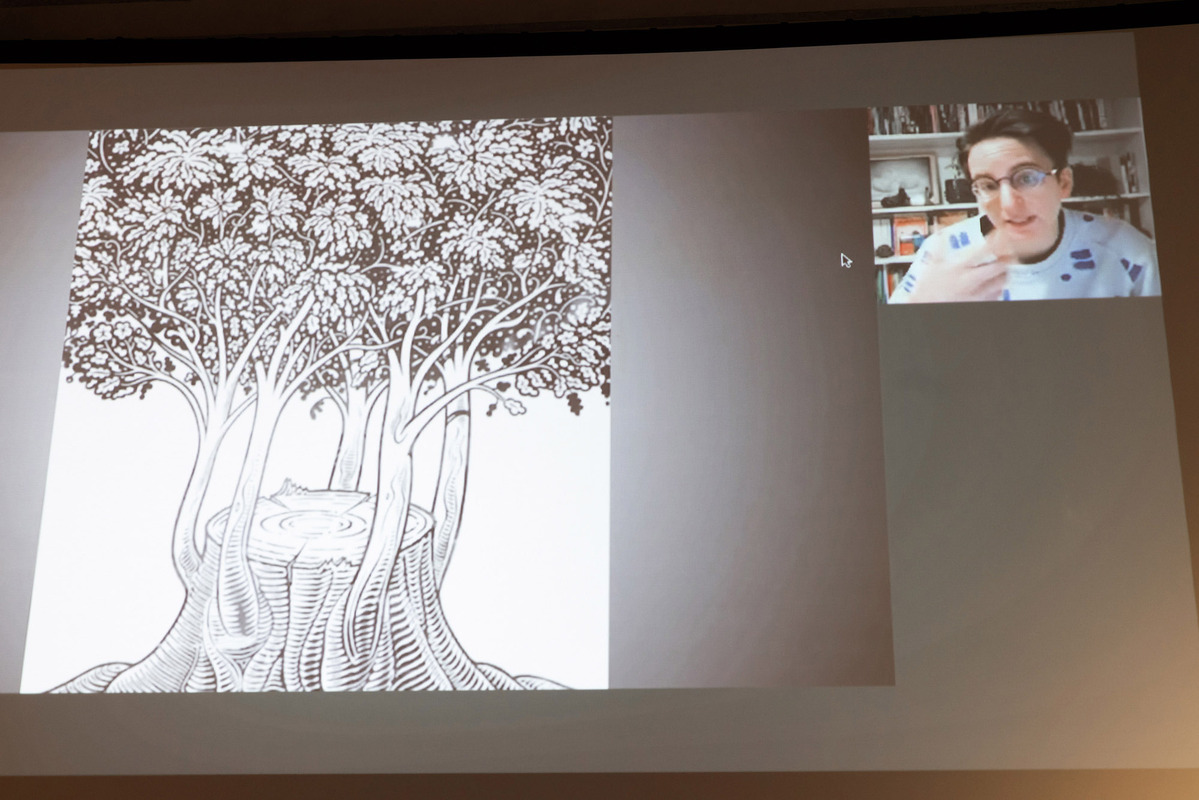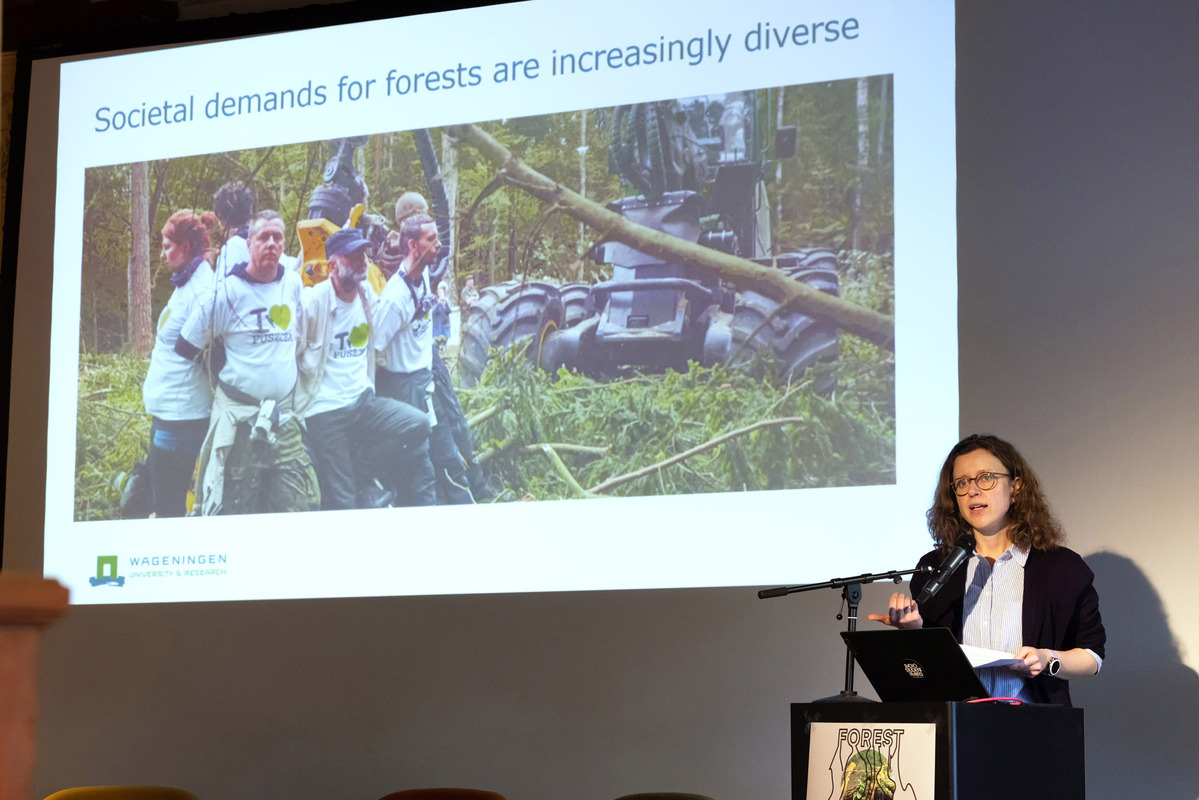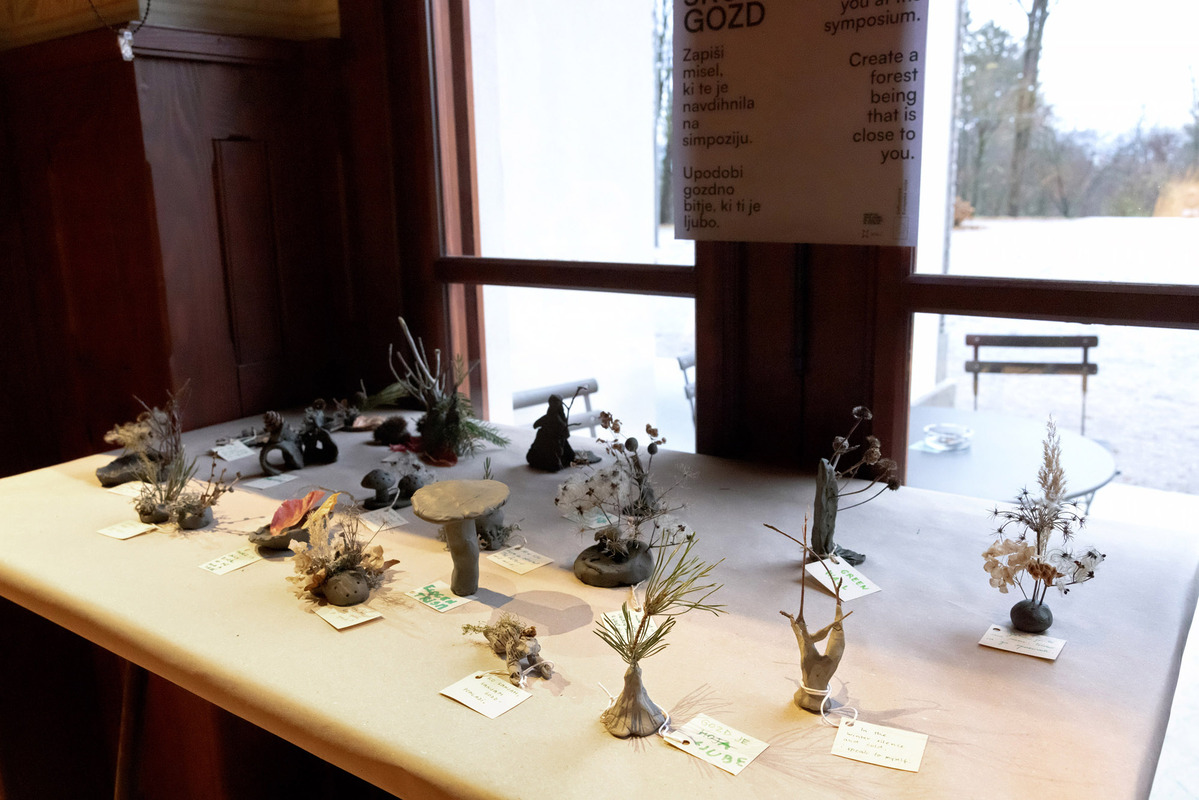Forest Encounters Symposium
1 December 2023, 9:30–15:15
MGLC / Švicarija, Pod Turnom 4, Ljubljana
Speakers: Giovanni Aloi, Agata A. Konczal, Ana Kučan, Teo Hrvoje Oršanič, Maja Simoneti, Borbála Soós
Moderation:
Urška Jurman, Mateja Kurir
The Forest Encounters symposium aims to develop a multifaceted and interdisciplinary understanding of diverse values, meanings, challenges, and perspectives related to forest. Bringing together different disciplines, the symposium approaches the forest as a site where we can explore ecology and interconnectedness but also as a site of diverse and often conflictual policies, and social, cultural, and economic practices.
The symposium acknowledges both the human and other-than-human perspectives, the rights of humans to nature and the rights of nature, and discusses diverse imaginaries, concepts, and practices around the questions: What and how can we learn with and through the forest? How to meet the challenges of contemporary forest management? What forest disaster narratives tell us about modern society? What meanings are attached to the forest as a cultural landscape? How has artistic engagement with the forest changed over time? What kind of forest do we wish for and need for the future? What do we need to make that happen?
The programme is held in English. Entry is free of charge, but registration is required.
Biodiversity loss is recognized as part of the global environmental crisis. There is a broad scientific consensus that with the loss of biodiversity, we are not only losing the variety of species, habitats, and entire ecosystems, but we are also endangering our food security, health, climate system, and economy. As part of the European Green Deal, the European Union adopted the 2030 Biodiversity Strategy and the 2030 Forest Strategy. Both strategic documents propose several measures with which the EU and its member states have made a commitment to stop the loss of biodiversity and put biodiversity on the path to recovery by 2030. In Slovenia, international and European nature conservation requirements and recommendations have in principle been adequately integrated into forestry policy and legislation, and to a large extent also into modern forest management practices. This is primarily the result of historically established principles of sustainability as well as close-to-nature and multipurpose forest management. Nevertheless, certain forest species and habitats have an unfavourable conservation status. Therefore, additional action is needed and a number of important forest management questions must be answered: When is a beech tree old? Are forest production cycles primarily an economic or an ecosystem category? Should mechanized timber harvesting adapt to forests or the other way around? How do we deal with climate change? How do we deal with non-native and invasive species? How do we strengthen supervision/control in forests? How do we strengthen cooperation, communication, education, knowledge transfer, and data gathering systems?
Watch video recording here.
10:35 / Maja Simoneti: The Forest as a Common Good and the Challenges of Its Management
This lecture focuses on the future of the protection and development of urban forests and trees as our cities confront the effects of climate change. Simoneti stresses that contemporary urban forest management challenges need to be tackled with complex and broad-based methods that go beyond a narrow view of forestry and also include the interested public. These methods can be inspired by good practices from the past: the traditions of Slovenian forestry – known for its sustainable forest management – and organized nature conservation, which is closely linked to the activities of nature lovers. Simoneti compares the concept of the urban forest to the public park, the latter being the result of the planned conservation of natural resources and the spatial planning for the common good in both the European and Slovenian traditions.
The extent and complexity of urban forest management challenges nowadays speak to the necessity of building strong (cross-sectoral and civil society) alliances, and drawing on our knowledge and other resources in order to provide for the most effective protection and development of forests and trees in the urban environment. The future is always marked by the past, and the knowledge of past management methods could help us to more quickly find optimal solutions.
Watch video recording here.
10:55 / Borbála Soós: Rewilding as an Emergent Subject in Artistic Practices
“Nature” and “natural” are culturally constructed terms that carry many historical and social connotations and contradictions. Similarly, the opposition of forest and city, much like the opposition of wilderness and control, are long-standing paradigms that perpetuate the distance between these systems and support the exploitation of valuable resources and various groups of people. The concepts of the “jungle” and the “wild” were created by the imperial and colonial imagination to reject both the Other and Other spaces as being outside of its system of control.
In her talk, Borbála Soós presents the international group exhibition Ecologies of the Ghost Landscape: The Word for World is Forest that she curated at tranzit.sk in Bratislava in 2020. The exhibition considered a number of quickly disappearing species, both human and non-human cultures, and nature put to the service of border control policies. It also foregrounded the idea of rewilding as a revolutionary ecosystem management strategy – also in the social, political, and activist sense – that has the potential to give voice to the unwanted and erased, the subjugated and oppressed, the indigenous and endemic, the human and non-human. Where the Wild Things Are thus came to represent the anti-hegemonic where disorder and disobedience interrupt long unquestioned narratives and practices.
Watch video recording here.
11:15–12:00 / Discussion
The conversation between Teo Hrvoje Oršanič, Maja Simoneti, and Borbála Soós, moderated by Urška Jurman and Mateja Kurir.
• Break and Multisensory exercise in the forest by Jasminka Ferček
13:30 / Agata A. Konczal: Forests for an (Un)certain Future
This presentation draws on stories of a windstorm in the Tuchola Forest (Poland), bark beetle outbreaks in the Białowieża Forest (between Belarus and Poland) and the High Tatra (between Slovakia and Poland), and other forest disturbances. These and similar phenomena that have been increasingly observed across Europe are described as natural disasters or calamities, forest crises or the collapse of the nature management paradigm, or the end of traditional forestry. It depends on where you ask and to whom you are talking.
When pondering the question of what is happening in modern society and how to describe its contemporary dynamics, it is worth pausing to explore what is seen and portrayed as a forest, or more broadly, a natural disaster. Forest disaster narratives are not neutral or naïve. On the contrary, they reflect power relations and are related to more complex discourses, becoming exemplifications of specific worldviews. Definitions of natural disasters and questions about what climate change is, when and where disasters take place, whether something is “natural” or belongs to the “natural order”, and how specific disasters are categorized as a result, have become integral parts of social debate. These various and competing meanings constitute a platform for social conflicts, where polarizing and binary opposition-based language dividing reality into nature and culture, natural and manufactured, native and foreign no longer fulfills its dialogical function. Disaster narratives have become spaces of the struggle for power, dominance, resources, and identity. They are situated somewhere between the “old Earth” (Latour, 2017) and alternative visions of the future. They are part of our search for an (un)certain future.
Watch video recording here.
13:50 / Ana Kučan: Forest as a Cultural Landscape – Silent Potentiality
This lecture introduces the forest as a complex element of cultural landscape and an important factor in cultural identity. Rather than on the ecosystemic and economic “value” and role of the forest, it focuses on the semiotics of forest’s spatial perception, and, to support this perspective, includes examples from literature, art, and landscape design. The assumptions upon which the western relation to the forest lie, and which at least partially emerge from the structural characteristics of the forest (that it is pathless, not easy to survey, dark and unfathomable), are filled with contradictions. We look at the forest as a space of freedom which evades control, but because of this it is also a space where laws do not easily apply. We look at the forest as a sanctuary and also as a place that is filled with danger, as a space of the transcendent (for example, the sacred grove), as a space of delusion and revelation, and also as a space that has experienced profane exploitation, and all of this – in addition to the fear, awe, and scientific inquiry – determines our current relation to the forest in light of contemporary ecological and social problematics.
Watch video recording here.
14:10 / Giovanni Aloi: Remembrance and Recovery – On the Fragility and Persistence of Nature (recording)
In his talk, Giovanni Aloi explores the relationship between the forest and loss as envisioned in art across time. In Renaissance paintings, forests regularly figure as a backdrop and reminder of the darkness lurking at the edges of reason. In contrast, the well-lit human characters in the foreground embody human rationality. The nature versus culture dichotomy is thus subliminally reinforced by beautiful images that – in terms of perspective – place the human being at the centre of the cosmos. For centuries, the metaphorical and actual impenetrability of the forest in Western art has intertwined in representations designed to remind us (or convince us) that we do not belong in nature, that we left it a long time ago, and that the forest essentially is a place of loss in the sense of losing our way, our faith, our sanity, our life.
Drawing on the work of artists as radically diverse as Otto Marseus van Schrieck, Wifredo Lam, and Abel Rodríguez, Aloi explores the different ways in which artists engage with forests as sites of remembrance and recovery rather than of loss and mourning. In order to foreground an awareness of the fragility and resilience of vegetal ecosystems in the face of human intervention, Aloi focuses on a work entitled Sildewalk Forests created by Chilean artist Cecilia Vicuña in the 1980s.
Watch video recording here.
14:30–15:15/ Discussion
The conversation between Agata A. Konczal, Ana Kučan, and Giovanni Aloi, moderated by Urška Jurman and Mateja Kurir.
ABOUT THE SPEAKERS & MODERATORS
GIOVANNI ALOI, PhD, is an author, educator, and curator specializing in the representation of nature and the environment in art. Currently Aloi is lecturing at the School of the Art Institute of Chicago. He is the editor-in-chief of Antennae: The Journal of Nature in Visual Culture. He is also the author of many books, including: Art & Animals (2011), Speculative Taxidermy: Natural History, Animal Surfaces, and Art in the Anthropocene (2018), Why Look at Plants? The Vegetal Emergence in Contemporary Art (2019), Posthumanism in Art and Science (2020), and Estado Vegetal (2023). Aloi has contributed to BBC radio programs, worked at the Whitechapel Art Gallery and Tate Galleries in London, and has curated exhibitions in the US and Europe. He currently is US correspondent for Esse Magazine and is co-editor of the University of Minnesota Press series Art after Nature. https://www.aloi.info/
AGATA A. KONCZAL has a PhD in social and cultural anthropology (2017). She specializes in environmental anthropology, political ecology, environmental history, and forest anthropology in particular. In her research, she explores how the social worlds of people are connected to the natural landscapes of forests. She grew up in the Tuchola Forest in northern Poland. She has been working since May 2022 at Wageningen University in the Forest and Nature Conservation Policy Group. Between 2017 and 2022, she worked for the European Forest Institute where she led the European Forest Governance and Society Team. In 2014, she was a visiting scholar at the University of Alberta in Edmonton, and in 2015 and 2016 at Aarhus University. Konczal is currently developing the Forest Anthropology Network with Dr. Jodie Asselin from the University of Lethbridge.
ANA KUČAN is a landscape architect and professor at the Department of Landscape Architecture at the Biotechnical Faculty of the University of Ljubljana where she teaches landscape design and theory. She received her master’s degree in urban design in 1992 at the Graduate School of Design, Harvard University, and her PhD at the University of Ljubljana in 1996. Her dissertation entitled Krajina kot nacionalni simbol [Landscape as National Symbol] was published in 1998. She is the director of Studio AKKA, a landscape architecture and urban design studio. She has designed a number of award-winning and internationally renowned projects, and has lectured at institutions in Europe and the US. She was the leading team member of the project All Shades of Green exhibited at the Slovenian Pavilion at the 12th Architectural Biennale in Venice in 2010. Kučan also works as an editor and author. She wrote columns for the Slovenian daily newspaper Dnevnik (2015–21) and was a member of the Landscape Architecture Europe editorial team.
TEO HRVOJE ORŠANIČ completed his bachelor’s degree in forestry and his master’s degree in natural science in the field of nature conservation at the Biotechnical Faculty of the University of Ljubljana. After working in business for ten years, he moved into the public sector. He was employed first at the Slovenia Forest Service, and then became the director of Kozjansko Regional Park. Since 2018, he has served as the director of the Institute of the Republic of Slovenia for Nature Conservation.
Even as a student, Oršanič was actively interested in the relation of society to nature. In his opinion, the essence of nature conservation lies in connection and cooperation, because many fields overlap in nature conservation: economics, tourism, agriculture, education, culture, and social services. He emphasizes that the most important part of nature conservation is working with people. Oršanič is also a passionate nature and landscape photographer whose work has been shown in both local and international exhibitions.
MAJA SIMONETI, PhD, is a landscape architect, spatial planner, and researcher currently employed at the Institute for Spatial Policies (IPoP) in Ljubljana. Her primary fields of interest are planning and managing green and public spaces, collaboration with the public in spatial planning, and creating connections between spatial and urban planning, active mobility, public health, and responses to climate change. Simoneti is an advocate of public interests in spatial planning, a member and former president of the Slovenian Association of Landscape Architects, and an honorary member of the Chamber of Architecture and Spatial Planning of Slovenia which awarded her the Platinum Pencil Award for her life work in 2022. Simoneti has authored and co-authored many planning studies, conceptual proposals, competitive tenders, scientific and popular articles, and publications such as Mestne zelene površine [City Green Spaces], Mestno drevje [City Trees], and Pot, največja načrtovana zelena javna površina [Path of Remembrance and Comrades: The Biggest Planned Green Public Space].
BORBÁLA SOÓS (b. Budapest) is a London-based curator and an active advocate, participant, and organizer of artistic and ecological research. Her practice engages with environmental thinking and related social, political, and decolonial necessities. She received her master’s degree in curating contemporary art in 2012 at the Royal College of Art, London, and in film studies and art history in 2009 at the Eötvös Loránd University, Budapest. She is currently the appointed curator at the Stanley Picker Gallery in London. Soós worked at Eastside Projects in Birmingham (2022–23), conducted an ACE DYCP funded research on rewilding and decolonial curatorial practice, and was a Research Associate at CCA in Derry~Londonderry, Northern Ireland (both 2020–22). She was also the director and curator at Tenderpixel in London (2012–19). As an independent curator, Soós has collaborated with institutions such as the Camden Arts Centre and ICA in London, the OFF-Biennale in Budapest, and the Kunsthalle in Bratislava. Since 2015, she has been regularly invited to be a visiting lecturer by universities including Edinburgh College of Art, the Goldsmiths College, the Royal College of Art, and the Central Saint Martins in London. http://borbalasoos.co.uk/
URŠKA JURMAN is an art historian and sociologist of culture. She is active as a curator, editor, and writer in contemporary art. Her work intersects art, critical spatial practices, ecology, and active citizenship. She is a co-founder of the Obrat Culture and Art Association, with which she co-authored many projects, including the community garden Beyond a Construction Site (2010–22). In 2021 she co-initiated (with Elke Krasny) the Ecologies of Care working group. Since 2013, she has been the Igor Zabel Association for Culture and Theory program director in Ljubljana.
MATEJA KURIR is a philosopher, researcher, and editor. She was a visiting researcher at the Department of Architecture, KU Leuven (2015), and a postdoc researcher at the University of Rijeka (2017). Currently, she is the manager of LINA – European Architecture Platform. Together with Ana Kučan she co-edited Garden and Metaphor (2021 in Slovenian, 2023 in English by Birkhauser). As the editor of O oblasti v arhitekturi [On Power in Architecture, 2021 in Slovenian, 2024 in English by Routledge], Kurir received the Plečnik’s Medal 2022 in the field of architectural theory, criticism, and publication.
JASMINKA FERČEK is a textile artist with a master’s degree in art therapy. For twenty years, she has worked with the Oloop collective in the field of participatory and psycho-social practices in art and design. Currently, she is studying to become a Nature–Based Expressive Arts Practitioner.
The symposium is conceived and organized by the Igor Zabel Association for Culture and Theory in collaboration with Mateja Kurir and Polonca Lovšin, and with the support of the International Centre of Graphic Arts (MGLC Švicarija).
Co-funded by the European Union, Ministry of Culture of the Republic of Slovenia, and Ministry of Public Administration of the Republic of Slovenia.









